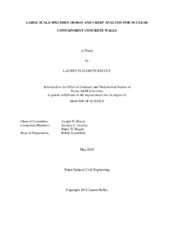| dc.description.abstract | Nuclear containment facilities in the US are quickly approaching the end of their design lives. However, due to the need for energy and the staggering cost of constructing new facilities, the industry is hoping to push the service lives of existing structures upwards of 80 years. Therefore, it is necessary to identify the risks associated with long term use of such facilities. Since these structures are typically post-tensioned concrete containment vessels, one of the main concerns is the phenomenon known as concrete creep.
This study focuses on observing the effects of concrete creep by constructing three large scale reinforced concrete wall sections to model variable contributing factors to the creep phenomenon. Concrete strains and temperatures through the thicknesses of the specimens, as well as the strain in select post-tensioning bars used to apply specimen stresses, are measured.
From six months of measured data since post-tensioning, there were noticeable changes in the post-tensioning bar strains and concrete strains, which is most likely the result of changes in ambient temperature in the winter months, and possibly creep. To confirm the field data values, a simple, static finite element model was developed to simulate concrete strain changes as a result of post-tensioning. The model confirmed the preliminary field data was closely related to the numerical estimations, with deviations stemming from the lack of complexity of the model. The model can be easily modified in the future to include concrete creep and other important physical occurrences that the specimens undergo in practical applications.
This research, in conjunction with materials tests being conducted in the lab by other students, will provide the framework for a powerful predictive creep model to be developed to analyze the expected lifespans of such existing structures. | en |


